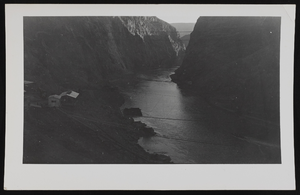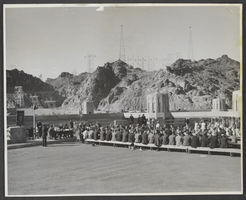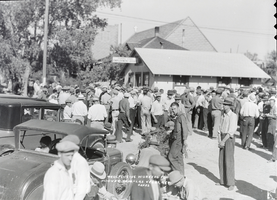Search the Special Collections and Archives Portal
Search Results
Junior League of Las Vegas Photograph Collection
Identifier
Abstract
The Junior League of Las Vegas Photograph Collection contains photographic prints and negatives, as well as postcards of locations in and around Las Vegas, Nevada between approximately 1900 and 1980. Early photographs in the collection offer views of the Las Vegas townsite, buildings, railroads, the Las Vegas High School, Overland Hotel, Arizona Club, and residential areas. Other photographs during this time depict the Hoover Dam (Boulder Dam) construction and Death Valley, California. Later photographs show the University of Nevada, Las Vegas (UNLV) campus, downtown Las Vegas, and the Las Vegas Strip.
Archival Collection
An Interview with Paul Huffey and Michael Mack
Identifier
Abstract
Oral history interview with Paul Huffey conducted by Claytee D. White on February 02, 2010 for the Voices of the Historic John S. Park Neighborhood. Paul Huffey discusses his family moving to the John S. Park Neighborhood in 1947, his father working on the construction of Hoover Dam, and Huffey working at Ronzoni's Department Store when he was in high school. Huffey then discusses graduating from the University of Nevada, Reno and teaching history at Basic High School in Henderson, Nevada for nine years.
Archival Collection
Anita Freeman Photograph Collection on Southern Nevada
Identifier
Abstract
The Anita Freeman Photograph Collection on Southern Nevada (1937-1972) primarily contains black-and-white negatives depicting locations in Southern Nevada, including the Hoover Dam, Lake Mead, and Mount Charleston. The collection also includes black-and-white negatives of the Helldorado Parade held in Las Vegas, Nevada, as well as landscapes in Arizona, such as the Grand Canyon.
Archival Collection

Photograph of the Colorado River, approximately 1930-1933
Date
Archival Collection
Description
Image
Leo Dunbar, Harry Hall, Carl Merrill, Mary Ann Merrill, and Harold Wadman oral history interview
Identifier
Abstract
Oral history interview with Leo Dunbar, Harry Hall, Harold Wadman, Carl Merrill, and Mary Ann Merrill conducted by Dennis McBride on June 24, 1986 for the Boulder City Library Oral History Project. The interviewees discuss their early lives and families, moving to Nevada, and starting work on the Hoover Dam. They recall memories of living in Boulder City, Nevada during the Great Depression and beyond, and share information about the construction of the dam and the city as well as personal stories about their lives in Southern Nevada.
Archival Collection

Photograph of Rotary Club luncheon, Arizona, October 25, 1946
Date
Archival Collection
Description
Image
Albert Schouten oral history interview
Identifier
Abstract
Oral history interview with Albert Schouten conducted by Roger DeSart on February 26, 1979 for the Ralph Roske Oral History Project on Early Las Vegas. In this interview, Schouten discusses his family background in Las Vegas, Nevada dating back to 1924 and recalls growing up in Las Vegas. Schouten then describes the changes that the city went through and growth of Las Vegas at large. Later in the interview, Schouten discusses the bombing of Pearl Harbor, the opening of Boulder (Hoover) Dam with President Roosevelt, the increase in number of schools, and the construction of Nevada Southern University (later University of Nevada, Las Vegas). Lastly, Schouten shares his thoughts on how Las Vegas lost its sense of community, and discusses the increase of crime in Las Vegas.
Archival Collection

Film transparency of Federal-State Employment Office, Las Vegas, circa 1931-1936
Date
Archival Collection
Description
Image
Henry C. Wieking Photograph Collection
Identifier
Abstract
The Henry C. Wieking Photograph Collection contains black-and-white photographic prints and negatives, as well as postcards of Las Vegas, Nevada between approximately 1920 and 1940. These images primarily depict Wieking and his family in front of the Las Vegas Mormon Fort and Hoover Dam (Boulder Dam). Other photographs include Six Companies and United States Bureau of Reclamation vehicles, Mount Charleston, the Colorado River, Black Canyon, and desert scenes. The remaining images depict Barstow and Death Valley, California; and a Grand Canyon bridge in Arizona.
Archival Collection

Transcript of interview with Steven Liguori by Claytee White, January 20, 2010
Date
Archival Collection
Description
Steven Ligouri is an artist who is a born and raised Nevadan whose artistic creations can be enjoyed at such places as the Hoover Dam, where his famous High Scaler sits comfortably [above left photo]. The stories of this statue and others are included within this interview. Steve began mastering his trade as a youngster making jewelry with assistance of his father, Bruno Ligouri who owned a turquoise shop in Boulder City. Since his birth in 1962, Steve has lived in several locations: a family farm in North Las Vegas, John S. Park neighborhood, in Boulder City, and eventually back to John S. Park. Returning to the John S. Park neighborhood after a 22-year absence gives him the chance to reflect on the changes that have occurred. Steve fondly calls the neighborhood "home" and firmly believes it can reach its potential.
Text
